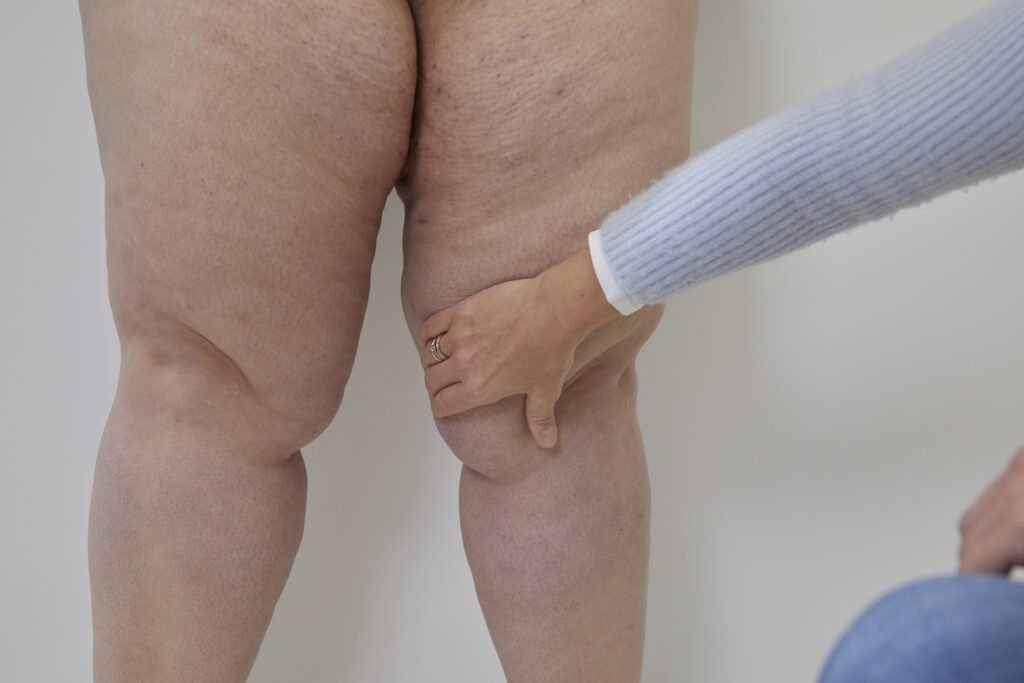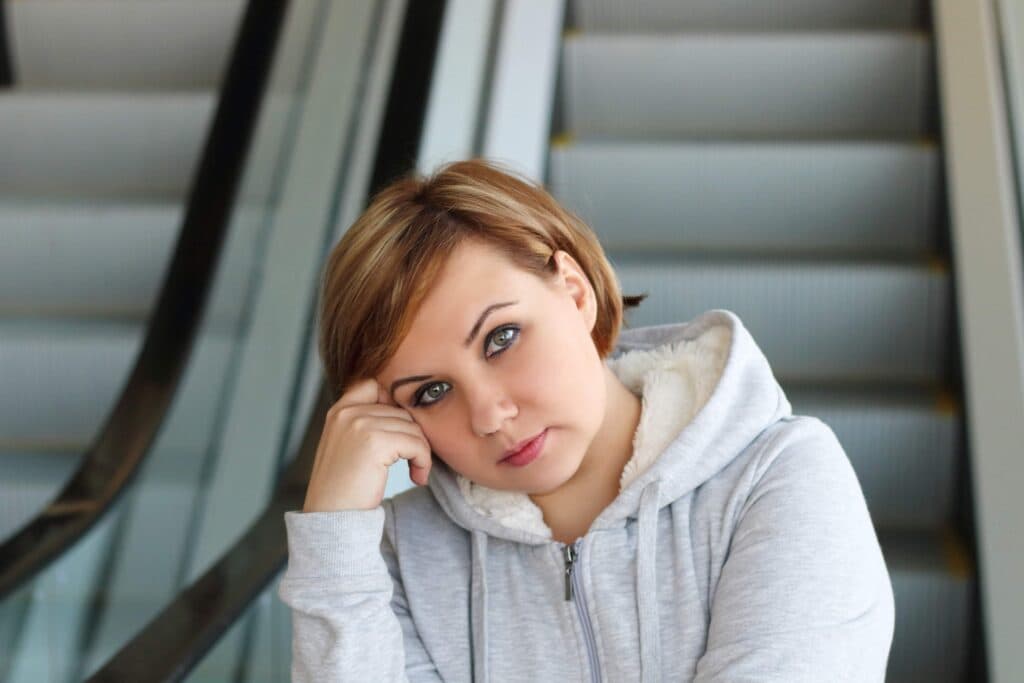The leading clinic for diagnosis and treatment of lipedema
New freedom
for body and mind
About one in ten women is affected by lipedema – a disease that everyone can see yet few are aware of.
As a pioneer in the surgical treatment of lipedema, the LipoClinic is a worldwide leader, successfully performing more than 2,500 operations every year.
We raise awareness of the physical and psychological suffering experienced by those living with lipedema, campaign for recognition of lipedema as a disease and tackle lipedema around the world.
Lipedema
Physical and emotional stress
Lipedema is a pathological fat distribution disorder that causes pressure pain and feelings of tightness and predominantly affects women. Health professionals and researchers currently believe that the onset of lipedema is triggered in 85 % of cases by hormonal changes such as puberty or pregnancy. A genetic predisposition is another possible cause.

What is lipedema?
Lipedema is a chronic, frequently inherited and uncontrolled increase in the subcutaneous fatty tissue that is possibly triggered by female hormones.

What are the symptoms of lipedema?
Lipedema symptoms are often difficult to classify because of how they appear and their similarity to the symptoms of other disorders.

Do I have lipedema?
You can use this initial test to check if you may be affected by lipedema. Complete the check here.

What are the stages and types of lipedema?
Because lipedema is a chronic and progressive fat distribution disorder, it is divided into stages and types.

What are the treatment options for lipedema?
Liposuction as part of a lipedema operation is the only lasting treatment for lipedema.

Haben Sie Fragen?
In our FAQs you can find more information about lipedema and the treatment methods.
Do I have lipedema
?
If you have several of the relevant symptoms, we recommend that you obtain a conclusive diagnosis from a specialist (phlebologist/lymphologist).

Do I have lipedema
?
If you have several of the relevant symptoms, we recommend that you obtain a conclusive diagnosis from a specialist (phlebologist/lymphologist).
INTEGRATED TREATMENT
You are at the heart of all we do
The LipoClinic campaigns for effective treatments for and intensive research into lipedema. It is particularly important for us that patients’ environments and psychological factors are considered in any therapies.
We are all too familiar with the long and painful journey that you have been on. It is a journey that is often characterised by ignorance and misunderstanding about the disease, leaving those affected feeling alone and misunderstood. Based on our many years of experience, we want to help you take a step towards a new life without lipedema.
FAQ
Short and sweet
Here are answers to your most important questions about lipedema and the treatment options.
If women who live with lipedema are asked whether they are in pain, the answer is unfortunately often no. This is because lipedema symptoms are not perceived in the same way as classic pain such as a headache, a burn or lower back pain and are difficult to describe. But tired or heavy legs, a marked sensitivity to touch, a more pronounced feeling of coldness or tension in the legs are signs that you should have investigated by a specialist.
There are a number of specialist disciplines that can diagnose lipedema. One group of specialists that deal with the disease lipedema are phlebologists, doctors who diagnose, treat and rehabilitate venous diseases. Another specialist group are lymphologists who examine swelling of tissues and diagnose or rule out diseases of the lymphatic system. Angiologists also investigate and recommend treatment options for occlusive arterial disease and varicose veins as well as lymphedema.
The first measure when treating lipedema is conservative decongestive therapy with a custom-made flat-knit compression garment with a compression level of 23-32 mmHg and manual lymphatic drainage (MLD). This type of therapy alone is not enough to treat lipedema but, along with normalising weight by exercising and eating a sensible diet, it is an essential factor in the reduction of symptoms.
The only sustainably effective treatment for lipedema is liposuction as part of lipedema surgery. Systematically and competently performed surgery consistently achieves outstanding results with very few complications. In the LipoClinic we perform more than 2,500 lipedema decompressions every year, making us the worldwide leader in lipedema surgery. In just a few days, most of our patients experience a considerable reduction in their pain and often do not need any additional therapies such as compression or lymphatic drainage in the long term.
Lipedema and other diseases can lead to reduced drainage of lymphatic fluid from tissues. This ultimately leads to symptoms of congestion in the calves – one of the typical first symptoms of lipedema. After surgery there is also an increase in the lymphatic fluid in the tissues. For this reason, a diagnosis of congestive lipedema often includes a prescription for manual lymphatic drainage (MLD) as part of conservative decongestive therapy. Most cases of lipedema do not need an ongoing prescription for MLD – a good result can be achieved with lymphatic drainage every day or every second day over six to eight weeks, leading to a slimmer leg.
With lipedema, the pathological fatty tissue produces too much lymphatic fluid, which accumulates in the tissue and places stress on the lymphatic system. A prescription for custom-made flat-knit compression garments helps to decongest the tissue using compression and regular exercise. Flat-knit compression garments help to mobilise the lymph and draw away fluid that has accumulated in the tissue.
Wearing a flat-knit compression garment is essential before the lipedema surgery because decongested, soft connective tissue on the leg is optimal for planned surgery. Even after surgery, flat-knit compression garments play a big role because they quickly alleviate swelling and bruising and dynamically massage any remaining fluid out of the tissue.
Round-knit compression garments are helpful with venous disorders such as after surgery for varicose veins. They create compression on the veins so that the valves in the veins close again.
Flat-knit compression garments are used as conservative therapy for lipedema. During daily activities, they have a permanent decongestive effect on the tissue and lymph vessels and help with decongestion and drainage of excessive fluid.
Pregnancy and the associated hormonal changes may contribute to a significant deterioration in untreated lipedema.
Fortunately, we can now diagnose lipedema in its early stages. Women are also becoming mothers later in life. This means that lipedema surgery can be calmly planned and performed to prevent any deterioration in the lipedema caused by pregnancy.
The optimal time for lipedema surgery is before the first pregnancy. Our experience in the LipoClinic shows that once the lipedema surgery is complete, it is highly likely that further pregnancies will neither rekindle the lipedema nor promote increased formation of fat cells.
Lipedema cannot be eliminated by playing sport or specific diets but sport and lipedema do go together. For women with lipedema, it is fundamentally important to keep active. Doing more exercise, which includes long walks, aqua gymnastics and walking up and down steps, is simply good for body and soul. It’s not about tackling lipedema with sport but instead changing your life for the long term. We want you to have fun or learn to have fun exercising and being active. At the same time, other parts of your body that are not affected by the lipedema can be more easily slimmed down by sport and exercise – this ensures a positive outcome for your whole body and a new lightness in the truest sense of the word. It is also important to always eat a nutritionally balanced diet.
Along with compression, exercise and also surgery, a sensible diet – and therefore the weight of women with lipedema – is an important factor. The aim is not to quickly lose weight but to ‘increase well-being and fitness over the long term by eating a healthy and nutritionally balanced diet’. Weight loss is nevertheless important in many cases for the overall success of the treatment. Eat a sensible, healthy and balanced diet. Drop refined sugar, processed foods and ready-to-eat meals from the menu and instead eat natural and unprocessed whole-grain foods as much as possible. Observe yourself and listen to your body, because you will certainly find a diet that works for you. This means that you can contribute to treating the symptoms of your lipedema and improve your quality of life for the long term.